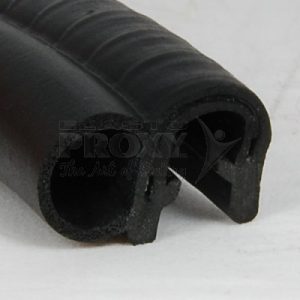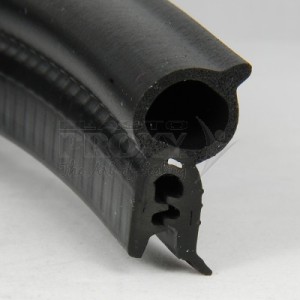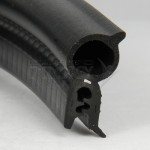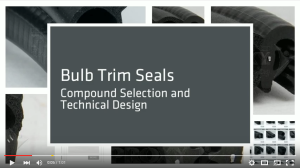EPDM Trim Seals
EPDM trim seals provide excellent resistance to water, weather, ozone, aging, and steam. You can buy them in low-to-medium volumes from Elasto Proxy.
EPDM trim seals provide excellent resistance to water, weather, ozone, aging, and steam. You can buy them in low-to-medium volumes from Elasto Proxy.
Get bulb trim installation tips from Elasto Proxy. We supply trim seals to manufacturers. Bulb trim seals keep out air, water, dust, and noise. They are used in doors with…
A bulb trim seal is a rubber gasket that provides sealing and insulation for doors or hatches with radiused corners. This type of industrial rubber product is sometimes called a…
 Bulb trim provides sealing and insulation for doors, hatches, and enclosures with rounded corners. These industrial rubber products have separate bulb and retainer sections, each of which can have a different durometer or hardness. The bulb forms a seal under low-to-medium closure force. The retainer or trim is pressed into place over a flange and may have an integral tongue or metal clips to promote attachment.
Bulb trim provides sealing and insulation for doors, hatches, and enclosures with rounded corners. These industrial rubber products have separate bulb and retainer sections, each of which can have a different durometer or hardness. The bulb forms a seal under low-to-medium closure force. The retainer or trim is pressed into place over a flange and may have an integral tongue or metal clips to promote attachment.
Elasto Proxy supplies a wide variety of bulb trim seals and can custom-fabricate finished gaskets that save time and money on your assembly line. In this article, you’ll learn how to choose the right bulb trim for your application. Whether you work in engineering, procurement, or production, compound selection and part dimensions are critical. Product features vary, too. (more…)
![]() Bulb trim seal compounds, colors, and approvals may surprise you.
Bulb trim seal compounds, colors, and approvals may surprise you.
Bulb trim seals don’t just come in EPDM rubber. They’re available in colors besides black, too. That’s good news if you need to use recyclable materials, or if you’re searching for colorful sealing solutions to complement distinctive product designs. Bulb trim seals that contain EPDM aren’t all the same either. Some meet specific industry or regulatory standards. Others are made of harder or softer rubber.
Do you need bulb trim seals for doors, hatches, or enclosures? In this week’s blog entry, Elasto Proxy’s last for 2017, we’ll finish the year with a flourish – and with a look at some of the compounds, colors, and approvals for bulb trim seals. Black EPDM gaskets are available if you need them, but procurement and engineering personnel may have more choices in compounds than they may realize. (more…)
 Bulb trim seals are used with doors, hatches, and enclosures. They have two sections: the bulb and the retainer. The bulb section provides sealing and insulation under compressive force. The trim or retainer section presses onto a flange or substrate.
Bulb trim seals are used with doors, hatches, and enclosures. They have two sections: the bulb and the retainer. The bulb section provides sealing and insulation under compressive force. The trim or retainer section presses onto a flange or substrate.
Elasto Proxy supplies many different types of industrial rubber products, but there are three things about bulb trim seals that engineers need to know. (more…)
 Bulb trim seals provide sealing and insulation for doors, hatches, and enclosures. These industrial rubber products have bulb and retainer sections that are made of different materials. The bulb section provides sealing and insulation under compressive force. The trim or retainer presses onto a flange or substrate. Each section of the seal also has a different durometer or hardness to support proper compression.
Bulb trim seals provide sealing and insulation for doors, hatches, and enclosures. These industrial rubber products have bulb and retainer sections that are made of different materials. The bulb section provides sealing and insulation under compressive force. The trim or retainer presses onto a flange or substrate. Each section of the seal also has a different durometer or hardness to support proper compression.
This technical article from Elasto Proxy is designed to help you choose the right bulb trim seals for your application. In addition to compound selection and part dimensions, product designers and technical buyers need to consider color, texture, internal supports, and exterior finishes. Your application may also require flame-resistant compounds or rubber that meets specific industry standards. (more…)

Bulb trim seals are sealing and insulation products with bulb and retainer sections. The bulb portion is often rounded or teardrop-shaped, but may resemble a half-moon or have a flat bottom. The retainer portion of the seal has a U-shape with an open end and two “legs”. The bulb provides sealing and insulation under compressive force, and the retainer or trim section presses onto the flange or substrate.
Each section of the seal (bulb and trim) are made of different materials. In turn, each material has a different durometer or hardness to support compression. For technical buyers and product designers, it’s important to choose the right materials and account for design factors such as bulb size, gap or edge thickness, and minimum bend radius. The following sections explain. (more…)
Doug Sharpe President of Elasto Proxy Dual-Durometer Rubber Bulb Trim Seals Bulb trim seals are dual durometer rubber seals with bulb and retainer sections. Typically, the bulb is made of…